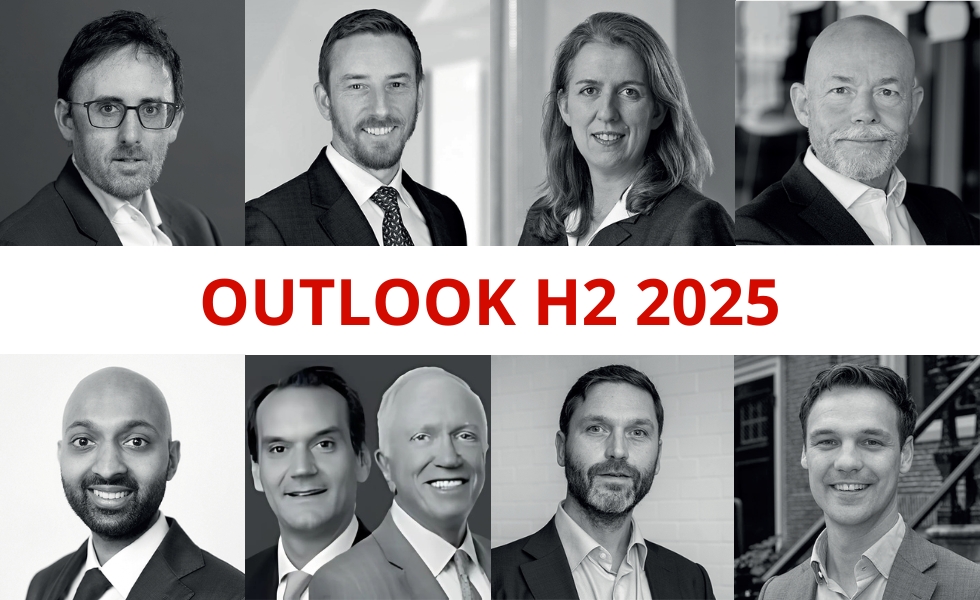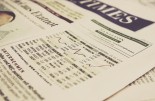Outlook for the second half of 2025: A turbulent start, followed by resilience?

This article was originally written in Dutch. This is an English translation
The financial markets had a turbulent start to 2025. The introduction of import tariffs by President Trump caused fluctuations on global markets.
By Esther Waal
Trump's “Liberation Day” on 2 April, when he announced a universal 10% tariff on all imported goods with additional tariffs of 34% on Chinese and 20% on European products, caused a global stock market crash, with US stock markets experiencing their biggest decline since the coronavirus pandemic. The S&P 500 fell by 4.88%, the Nasdaq by 5.97% and the Dow Jones by 3.98%. Within a few days, more than $3 trillion in market value evaporated. In addition, the announcement caused the US dollar to fall and increased tensions with trading partners such as China and the European Union.
But the turmoil was also fuelled in other areas. In Europe, Germany in particular presented a turbulent picture, with disappointing growth figures and political unrest. Following the collapse of the coalition government at the end of 2024 and the subsequent early elections, the German economy came under pressure, despite plans for significant investment in defence and infrastructure.
Economic growth in China slowed, mainly due to weak domestic consumption. Ongoing conflicts in Ukraine and Gaza, increased military spending by major powers and rising energy prices further contributed to market uncertainty.
Nevertheless, the markets have remained remarkably resilient so far. What does the rest of the year hold? Nine experts share their views on the risks, opportunities and strategies for investors in the second half of 2025.
|
Jaron Krant Investment Strategist, InsingerGilissen
What is the economic outlook for the rest of 2025? ‘Despite the recent de-escalation in the trade war, we expect the average US import tariff to rise sharply in the end. In addition, it remains to be seen to what extent weak confidence indicators will translate into lower consumer spending and investment. We expect President Trump's trade policy and the uncertainty surrounding it to lead to lower economic growth and higher inflation in the US. However, we believe that a recession will be avoided, thanks in part to strong household and corporate balance sheets, tax cuts and the positive effects of deregulation. For other regions, such as Europe and Asia, we foresee a smaller impact on growth and inflation. Policymakers here have more scope to support the economy with monetary easing and fiscal stimulus measures. Where are the biggest opportunities and threats for investors? ‘Against this backdrop, we find equity markets outside the US, such as those in the eurozone and Japan, relatively attractively valued. More investment in infrastructure and defence, and interest rate cuts by the ECB, are providing important support for European stock markets. The weakening of the US dollar that we anticipate offers upside potential for the yen. Corporate reforms in Japan are also improving profitability. In addition to a US recession, we see a sharp rise in US bond yields as one of the main risks for investors. Concerns about rising US government debt, high budget deficits and persistent inflation could push up US bond yields. This would put pressure on equity and bond markets across the board. |
|
Gordon Harding Fixed Income Product Strategist, Pimco
‘The world is currently experiencing significant geopolitical uncertainty, with the US at the center of this turbulence. The Trump administration’s aggressive measures to address trade deficits and reduce the size of the government have increased policy volatility, heightening global uncertainty, especially for export-dependent economies. This environment threatens the US’s recent economic and financial market exceptionalism as both business and consumer confidence decline. Protectionist US policies and potential government spending cuts have raised concerns about recession risks and inflation in the US. Meanwhile, prospects for increased fiscal spending are improving outlooks for countries like Germany and China. Major central banks are expected to continue easing policies toward neutral levels. This US-led uncertainty has triggered a sell-off in risk assets and increased market volatility. Conversely, high-quality bonds have performed well, delivering returns comparable to equities over the past year, and currently offering attractive valuations. In this turbulent environment, it is advisable to seek stable sources of return. Attractive bond yields suggest bonds are well-positioned, making it a potentially good time to look at global opportunities. Investing across global fixed income markets in highquality, diversified bonds can potentially enhance portfolio resilience. Additionally, allocating to global investment grade credit or securitized assets, such as governmentguaranteed agency MBS, can potentially strengthen a portfolio. In private markets, asset-based finance is preferred over corporate credit for its relative stability and risk profile.’ |
|
Julie Dickson Investment Director, Capital Group
What is the economic outlook for the rest of 2025? ‘The world has left the old order behind and recently entered the trade battlefront scenario, characterized by significant tariffs, technology export restrictions, and other protectionist measures that would accelerate economic decoupling and supply chain shifting. If the world remains in a protracted trade struggle, economic growth will likely be more subdued, and inflation could rise. If these tariffs are around long term, we are likely to see slower growth beyond 2025. On the other hand, if trade deals are struck relatively quickly, then a transition to the grand bargain scenario becomes more likely. This is a time to pay close attention to valuations and dividend income, when boring is beautiful.’ Where are the biggest opportunities and threats for investors? ‘After a long stretch of mega-cap tech dominance, Q1 saw a rotation into undervalued areas: health care, consumer staples, dividend payers, non-US equities, and small/mid-caps. Now more than ever, it’s important to navigate markets actively and selectively. A core allocation – rather than a focus on a particular style – feels most appropriate given today’s volatility and uncertainty. The reshoring trend in the US could benefit select industrials. Globally, overlooked pharmaceutical firms offer value, as do dividend-paying utilities, banks, and defense companies. Europe’s pivot to stimulate internal demand could boost domestically focused firms, while China’s travel and gaming sectors may benefit from recent developments. Despite volatility, elevated yields and lower correlations make bonds attractive, offering income and a buffer against equity swings. For example, high-quality global corporate bonds have delivered positive returns and diversification.’ |
|
Corné van Zeijl Investment strategist, Cardano
‘The outlook for the economy is currently fluctuating just as much as the stock market itself. This is, of course, due to the (impending) trade war. An additional effect is great uncertainty. In the US, many entrepreneurs say they plan to invest, while remaining cautious about possible policy changes that may occur in the near future. Investments are therefore likely to be limited. We are also seeing this uncertainty among consumers. Uncertain people do not consume; they prefer to save. The advantage is that this sentiment can also blow over just as quickly. Suppose things remain calm for the next six months, then consumers may come out of their shells and consume as usual. Labour market figures are particularly important in this regard. The opportunities for investors lie mainly in timing the market correctly. After “Liberation Day” on 2 April, we saw a strongly negative sentiment in the market. These are precisely the right moments to buy. Once the euphoria has subsided, it is a good time to sell. We are cautious on fundamental grounds, because equities are expensive and the outlook is uncertain. |
|
Raphie Hayat Investment strategist, a.s.r. asset management
What is the economic outlook for the rest of 2025? ‘If I were to translate the economic outlook into a weather forecast, it would be something like: “Foggy, with a chance of clearing up. But slippery, so there’s also a chance you’ll fall flat on your face.” Because we are in a macroeconomic environment that is a lot more uncertain than it was six months ago. This is mainly due to the policy uncertainty surrounding Trump's trade tariffs, but also to geopolitical flashpoints. Economic growth expectations are therefore moderate compared to the beginning of this year, although no recessions are expected yet. Where are the biggest opportunities and threats for investors? ‘We tend to see opportunities and threats as two separate things, but they are often two sides of the same coin. If you think a threat will not fully materialise, you can see it as an opportunity, and vice versa. One of the threats is that the trade war between the US and China will flare up again after the recent 90-day pause. The conflict between Russia and Ukraine could also escalate again. This may not have a direct impact on the real economy, but it could affect gas and oil prices, for example. Regardless of this, energy prices are an important wild card. If OPEC reduces production again, for example, this will be positive for energy prices but a negative shock for the economy. The challenge for investors is to assess the extent to which financial markets are sufficiently pricing in the current threats. Fortunately, there is a solution if you really don't know. Diversify well and take a long-term view. |
|
Mark Sherlock, Head of US Equities, Federated Hermes Limited, and Stephen Auth, Chief Investment Officer Equities, Federated Hermes
‘What will the second half of the year bring? To date, it’s all been about the White House with tariff talk dominating headlines. But could that be about to change? Sentiment has been dominated by executive orders, policy announcements, and tariff uncertainty. However, this may now have peaked, with the possibility of less volatile times ahead. While volatility may continue for a few weeks as individual tariff arrangements are agreed, we believe we are past the worst and that the second half of the year may prove more profitable for investors than the first. We anticipate a temporary pause in consumer and corporate spending as the ‘rules of engagement’ emerge, but US small- and mid-cap (SMID) companies are somewhat insulated from US-imposed tariffs due to their domestic focus. If tariffs force a re-alignment of the global supply chain, domestic small and midcaps should benefit from increased economic activity and demand. While volatility remains unnerving for investors, market ups and downs are neither unusual nor unwelcome. Data shows that since the inception of the Russell 2500 Index in 2004, investors have experienced average intra-year drops of 17.8%. Importantly, year-end annual returns have been positive in 16 of the last 21 years. Navigating the trade war was never going to be easy. We anticipated volatility, though maybe not to this degree! We advocate for a moderate overweight in equities, while waiting for a sign that the fog is beginning to lift or at least get less dense. Clearer days may be ahead. With the near-term voyage still fraught with pitfalls, the probability of a market-reset seems relatively high.’ |
|
Richard Abma Chief Investment Officer, OHV Asset Management
What is the economic outlook for the rest of 2025? ‘Financial markets are fluctuating between hope and fear due to the import tariff war unleashed by President Trump. This seems likely to dampen real economic growth for 2025. Consumers are becoming more uncertain and are facing higher product prices. Two-thirds of the American and European economies are driven by consumer spending. Consumer confidence therefore has an important influence in the short term. On the other hand, the job market in the US and Europe remains strong. There is still an acute shortage of personnel in many sectors. This is an important counterweight to the uncertainty surrounding the trade war. Consumers have income and will continue to spend it in the medium term. Central banks in Europe and the US will lower short-term interest rates by another 2 to 3 steps of 0.25% in the course of 2025. This will also support the economy and is likely to prevent a recession in 2025. Where are the biggest opportunities and threats for investors? ‘The biggest opportunities lie with healthy companies with low debt levels that have a strong market position and are responding to secular trends. These tend to be technology-related companies that are also responding to the growing need for AI applications for businesses and consumers. These types of companies have been hit hard by the trade war recently and therefore offer interesting entry levels for the medium term. Looking at the fixed-income side of investments, I see opportunities in the private debt environment. The interest premium that investors receive here for giving up a bit of liquidity and complexity is currently very high. As more institutional investors make the move to private debt, I expect this premium to decline. |
|
Ronald Verhagen Director, AF Advisors
‘Following recent updates, the IMF and World Bank now both expect global growth of around 3% for 2025, a slight downward revision from previous estimates. A gradual decline in inflation and more stable interest rates are creating room for moderate growth in investment and trade. Nevertheless, geopolitical tensions, protectionist tendencies and the ongoing disruptive effect of US politics remain key risk factors. The baseline scenarios assume that trade barriers will remain in place. If these are eased, there will be economic tailwinds relative to the baseline scenarios. Markets now appear to be anticipating easing, but this is wishful thinking rather than reality for the time being. This creates a landscape of increased volatility for investors, and diversification across regions, sectors and asset classes is not a luxury but a necessity. It forms the first line of defence against idiosyncratic shocks. Bonds with longer durations will benefit if central banks continue to cut interest rates. On the downside, there are short-lived but violent market reactions to trade rhetoric or unexpected geopolitical escalations. The TACO rule of thumb (‘Trump Always Chickens Out’) tempers panic, but does not eliminate headline risks. Moreover, if trade tariff easing fails to materialise, the fundamentals underpinning the current market will disappear, making renewed volatility inevitable. With strategic discipline and risk management, smart investors are creating room to exploit short-term opportunities. |


















